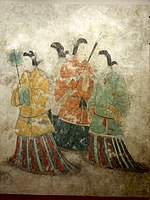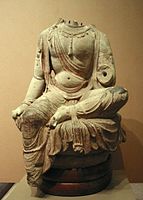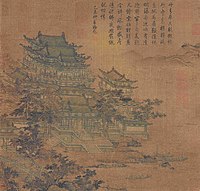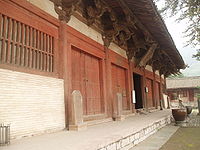Tang Dynasty Art 618 907 a D Court Lady

Silver vino loving cup, with birds and a rabbit amidst scrolling found forms.

Tang dynasty fine art (simplified Chinese: 唐朝艺术; traditional Chinese: 唐朝藝術) is Chinese art made during the Tang dynasty (618–907). The catamenia saw groovy achievements in many forms—painting, sculpture, calligraphy, music, dance and literature. The Tang dynasty, with its capital at Chang'an (today's Xi'an), the about populous city in the world at the time, is regarded by historians every bit a high point in Chinese civilization—equal, or even superior, to the Han catamenia. The Tang menstruum was considered the golden age of literature and art.
In several areas developments during the Tang set the direction for many centuries to come up. This was especially and then in pottery, with glazed plain wares in celadon green and whitish porcelaineous types brought to a loftier level, and exported on a considerable calibration. In painting, the flow saw the peak level of Buddhist painting, and the emergence of the landscape painting tradition known as shanshui (mountain-water) painting.
Trading along the Silk Route of various products increased cultural diversity in small China cities.[ane] Stimulated by contact with India and the Middle E, the empire saw a flowering of creativity in many fields. Buddhism, originating in what is modern day Bharat effectually the fourth dimension of Confucius, continued to flourish during the Tang menstruation and was adopted by the imperial family unit, condign thoroughly sinicized and a permanent part of Chinese traditional civilization. Block printing fabricated the written word available to vastly greater audiences.
Culturally, the An Lushan Rebellion of 745-763 weakened the confidence of the elite,[2] and brought an end to the lavish way of tomb figures, also as reducing the outward-looking culture of the early Tang, that was receptive to strange influences from farther west in Asia. The Great Anti-Buddhist Persecution, in fact against all foreign religions, which reached its peak in 845, had a not bad touch on all the arts, but peculiarly the visual arts, greatly reducing demand for artists.
Painting [edit]

A considerable corporeality of literary and documentary information about Tang painting has survived, but very few works, especially of the highest quality. There is a good deal of biographical data and art criticism, mostly from later periods such as the Ming dynasty, several centuries after the Tang; the accuracy of this needs to exist considered, and much of it was probably already based on seeing copies of the fine art, not originals. With a very few exceptions, traditional attributions of particular curl paintings to Tang masters are now regarded with suspicion by art historians.

A walled-up cave in the Dunhuang (Mogao Caves) circuitous was discovered by Aurel Stein, which independent a vast haul, mostly of Buddhist writings, but also some banners and paintings, making much the largest group of paintings on silk to survive. These are now in the British Museum and elsewhere. They are non of court quality, but show a variety of styles, including those with influences from further west. Equally with sculpture, other survivals showing Tang style are in Japan, though the most important, at Nara, was very largely destroyed in a fire in 1949.[3]
The stone-cut cave complexes and imperial tombs also contain many wall-paintings; the paintings in the Qianling Mausoleum are the most important group of the latter, by and large now removed to a museum. Not all the royal tombs accept withal been opened. Court painting generally survives in what are certainly or arguably copies from much later, such as Emperor Taizong Receiving the Tibetan Envoy, probably a later copy of the 7th century original past Yan Liben, though the front department of the famous portrait of the Emperor Xuanzong's equus caballus Night-Shining White is probably an original by Han Gan of 740–760.[four] Yan Liben is an example of a famous painter who was also a very important official.
Most Tang artists outlined figures with fine black lines and used brilliant colour and elaborate detail filling in the outlines. Still, Wu Daozi used only blackness ink and freely painted brushstrokes to create ink paintings that were so heady that crowds gathered to watch him work. From his fourth dimension on, ink paintings were no longer idea to be preliminary sketches or outlines to be filled in with colour. Instead, they were valued as finished works of art.
The Tang dynasty saw the maturity of the landscape painting tradition known as shanshui (mountain-h2o) painting, which became the most prestigious blazon of Chinese painting, particularly when practiced past amateur scholar-official or "literati" painters in ink-launder painting. In these landscapes, usually monochromatic and sparse, the purpose was not to reproduce exactly the appearance of nature but rather to grasp an emotion or atmosphere so as to take hold of the "rhythm" of nature.
-

-

Buddhist mural in the Bezeklik grottoes, 9th century
Pottery [edit]

Chinese ceramics saw many significant developments, including the beginning Chinese porcelain meeting both Western and Chinese definitions of porcelain, in Ding ware and related types. The earthenware Tang dynasty tomb figures are meliorate known in the West today, but were simply made to placed in aristocracy tombs close to the upper-case letter in the north, between about 680 and 760. They were perhaps the last meaning fine earthenwares to exist produced in Prc. Many are atomic number 82-glazed sancai (iii-colour) wares; others are unpainted or were painted over a slip; the paint has now often fallen off.
Sancai was also used for vessels for burial, and maybe for use; the glaze was less toxic than in the Han, merely perhaps yet to be avoided for utilise at the dining table. The typical shape is the "offering tray", a round or circular and lobed shape with geometrically regular floral-blazon decoration in the centre.
In the s the wares from the Changsha Tongguan Kiln Site in Tongguan are significant every bit the first regular utilise of underglaze painting; examples have been institute in many places in the Islamic globe. Notwithstanding the production tailed off and underglaze painting remained a minor technique for several centuries.[5]
Yue ware was the leading high-fired, lime-glazed celadon of the menstruum, and was of very sophisticated design, patronized by the courtroom. This was as well the case with the northern porcelains of kilns in the provinces of Henan and Hebei, which for the first time met the Western as well every bit the Eastern definition of porcelain, being a pure white and translucent.[six] One of the first mentions of porcelain by a foreigner was in the Chain of Chronicles written past the Arab traveler and merchant Suleiman in 851 AD during the Tang dynasty who recorded that:[7] [viii]
They have in Cathay a very fine clay with which they brand vases which are as transparent as glass; water is seen through them. The vases are fabricated of clay.
The Arabs were well used to glass, and he was sure that the porcelain that he saw was not that.
Yaozhou ware or Northern Celadon also began under the Tang, though like Ding ware its all-time period was under the side by side Song dynasty.
-

Yue ware vase with incised decoration, c. 900, "green-glazed porcelaneous stoneware"
-

"Offering plate" with sancai coat, 8th century.
-

"Offering plate" with sancai glaze, decorated with a bird and trees, 8th century.
-

"Offering plate" with sancai with six eaves and "three colors" glaze, 8th century.
-

Tomb figures: three of eight lady musicians on horseback, early 8th century
-

Ladies dancing, 7th century
-

Tomb effigy of a plump Tang woman
-

Tomb effigy of a foreigner with a wineskin, c. 674–750
-

Tomb figure, 7th-8th century
-
Tomb effigy of a Sogdian human wearing a distinctive cap and face up veil, possibly a camel rider or even a Zoroastrian priest engaging in a ritual at a burn down temple, 8th century AD
Sculpture [edit]

Nearly sculpture before the official rejection of Buddhism in 845 was religious, and a vast corporeality was destroyed during the Tang menstruum itself, with near of the balance lost in later periods. There were many statuary and wooden sculptures, whose style is best seen in the survivals in Japanese temples. Monumental sculpture in stone, and also terra cotta, has survived at several complexes of rock-cut temples, of which the largest and most famous are the Longmen Grottoes and the Mogao Caves (at Dunhuang), both of which were at their peak of expansion during the Tang. The best combined "the Indian feeling for solid, swelling form and the Chinese genius for expression in terms of linear rhythm ... to produce a style which was to become the basis of all later on Buddhist sculpture in China."[ix]
The tomb-figures are discussed higher up; though probably not treated very seriously as art by their producers, and sometimes rather sloppily made, and especially painted, they remain vigorous and effective as sculpture, especially when animals and foreigners are depicted, the latter with an element of caricature. A rather different class and type of tomb sculpture is seen in the reliefs of the 6 favourite horses at the mausoleum of Emperor Taizong (d. 649). By tradition these were designed past the court painter Yan Liben, and the relief is and then flat and linear that it seems probable they were carved after drawings or paintings.[10]
-
-

Tang dynasty bodhisattva statue missing its head and left arm
-

A limestone statue of a mourning bellboy, seventh century
-

Metalwork and decorative arts [edit]

Tang elite metalwork, surviving mostly in bronze or silver cups and mirrors, is oftentimes of superb quality, decorated using a diversity of techniques, and oft inlaid with golden and other metals. An uncommonly fine eolith is the collection in the Tōdai-ji in Nara in Japan of the personal goods of Emperor Shōmu, given to the Buddhist shrine by his daughter Empress Kōmyō afterward her father's death in 756. Also every bit metalwork, paintings and calligraphy, this includes piece of furniture, glass, lacquer and wood pieces such equally musical instruments and board games. Most is probably made in China, though some is Japanese and some from the Center East.[11]
Another of import deposit was discovered in 1970 at 11'an when the Hejia Village hoard was uncovered by construction. Placed into two large ceramic pots, 64 cm high, and a argent ane, 25 cm high, this was a large collection of over a g objects, birthday representing a rather puzzling collection. Several of them were gold or silvery vessels and other objects of the highest quality, equally well as hardstone carvings in jade and agate, and gemstones. It was probably hidden in a bustle during the An Lushan defection, in which the Tang capital letter was taken more than once. Many of the objects are imported, mostly from along the Silk Road, peculiarly Sogdia, and others show Sogdian influence.[12] 2 objects from the hoard (illustrated) are included on the very select official list of Chinese cultural relics forbidden to be exhibited abroad. The hoard is now in the Shaanxi History Museum.
-

Golden hexagonal silver plate with a Fei Lian beast blueprint
-
-
Mirror with floral medallion, plant sprays, birds, and insects, 7th century
Compages [edit]

There had been an enormous amount of building of Buddhist temples and monasteries, but in 845 these were all confiscated by the authorities, and the great bulk destroyed. The normal structure material for buildings other than towers, pagodas, and armed forces works in the Tang was still wood, which does not survive very long if not maintained.[13] The stone-cut architecture of the famous surviving sites of course survives neglect far improve, just the Chinese more often than not left the external facades of cavern-temples unornamented, dissimilar the Indian equivalents at sites like the Ajanta Caves.
Two big Tang pagodas survive in the capital, at present Eleven'an, which otherwise has few remains dating back to the Tang. The oldest is the Giant Wild Goose Pagoda, rebuilt in 704 in brick, and reduced in height subsequently harm in the 1556 Shaanxi earthquake. The Small Wild Goose Pagoda was likewise rebuilt in 704, but only lost a few metres in the earthquake. Some Tang pagodas tried to reconcile the grade with the Indian shikara temple tower, or fifty-fifty had a stupa every bit part of the superstructure; the Tahōtō at the Ishiyama-dera temple in Japan is a surviving later on case, with a roof on pinnacle of the stupa.[14]
The principal hall of the relatively small rural Nanchan Temple has a primary structure of wood. Much of it appears to take survived from the original structure in 782, and it is recognised as the oldest wooden building in People's republic of china. The third oldest is the main hall of the nearby Foguang Temple of 857.[fifteen]
Both are studied for their dougong bracketing systems, joining the roof to the walls. These complicated arrangements persisted until the stop of traditional Chinese architecture, but are frequently considered to take reached a top of elegance and harmony in the Song and Yuan dynasties, before condign over-elaborate and fussy. The Tang examples show an increase in complication before the peachy periods, and the beginnings of the uplift at the edges of roof lines that was to grow stronger in after periods. Nihon has preserved rather more temple halls congenital in very similar styles (or in many cases has carefully rebuilt them as verbal replicas over the centuries).[16]
-

Luoyang Pavilion by Li Zhaodao (fl. early 8th c.)
-

-
-

The 9 Pinnacle Pagoda of Shandong, completed by 756 and crowned with an unusual set of miniature pagodas; it is also unique for its octagonal, rather than foursquare, base plan.
-
Music [edit]
The offset major well-documented flowering of Chinese music was for the qin during the Tang dynasty, though the qin is known to have been played since before the Han dynasty.
Late 20th century excavations of an intact tomb of the catamenia revealed not only a number of instruments (including a spectacular concert bell set) but also inscribed tablets with playing instructions and musical scores for ensemble concerts, which are now heard again as played on reproduction instruments at the Hubei Provincial Museum.
Opera [edit]
Chinese opera is generally dated back to the Tang dynasty with Emperor Xuanzong (712–755), who founded the Pear Garden, the outset known opera troupe in China. The troupe mostly performed for the emperors' personal pleasure.
Poesy [edit]
The poesy of the Tang dynasty is possibly the most highly regarded poetic era in Chinese poetry. The shi, the classical form of verse which had developed in the late Han dynasty, reached its zenith. The album Three Hundred Tang Poems, compiled much later, remains famous in China.
During the Tang dynasty, poetry became popular, and writing poetry was considered a sign of learning. One of Prc's greatest poets was Li Po, who wrote near ordinary people and well-nigh nature, which was a powerful force in Chinese art. I of Li Po's short poems, "Waterfall at Lu-Shan", shows how Li Po felt nearly nature.
Tang dynasty artists [edit]

- Bai Juyi (772–846), poet
- Zhou Fang (730–800), painter, also known as Zhou Jing Xuan and Zhong Lang
- Cui Hao (?–754), poet
- Han Gan (718–780), painter
- Zhang Xuan (713–755), painter
- Du Fu (712–770), poet
- Li Bai (701–762), poet
- Meng Haoran (689 or 691–740), poet
- Wang Wei (699–759), poet, musician, painter
- Wu Tao-Tzu (680–740), famous for the myth of inbound an art piece of work
- Zhang Jiuling (678–740), poet
See also [edit]
- Chinese art
- Qianling Mausoleum
Notes [edit]
- ^ Birmingham Museum of Art (2010). Birmingham Museum of Art : guide to the drove. [Birmingham, Ala]: Birmingham Museum of Art. p. 24. ISBN978-i-904832-77-5.
- ^ Sullivan, 145
- ^ Sullivan, 132-133
- ^ Sullivan, 134-135
- ^ Vainker, 82–84
- ^ Vainker, 64–72
- ^ Temple, Robert K.G. (2007). The Genius of China: 3,000 Years of Science, Discovery, and Invention (3rd edition). London: André Deutsch, pp. 103–half-dozen. ISBN 978-0-233-00202-6
- ^ Bushell, S. Westward. (1906). Chinese Art. Victoria and Albert Museum Art Handbook, His Majesty's Stationery Office, London.
- ^ Sullivan, 126-127, 127 quoted
- ^ Sullivan, 126
- ^ Sullivan, 139-140
- ^ Hansen, 152-157; Sullivan, 139
- ^ Sullivan, 123-124
- ^ Sullivan, 125-126
- ^ Sullivan, 124
- ^ Sullivan, 124-125
References [edit]
- Hansen, Valerie, The Silk Road: A New History, 2015, Oxford University Press, ISBN 0190218428, 9780190218423, google books
- Sullivan, Michael, The Arts of China, 1973, Sphere Books, ISBN 0351183345 (revised edn of A Short History of Chinese Art, 1967)
- Vainker, S.J., Chinese Pottery and Porcelain, 1991, British Museum Press, 9780714114705
Farther reading [edit]
- Watt, James C.Y.; et al. (2004). Cathay: dawn of a golden age, 200-750 AD . New York: The Metropolitan Museum of Art. ISBN1588391264.
Source: https://en.wikipedia.org/wiki/Tang_dynasty_art






0 Response to "Tang Dynasty Art 618 907 a D Court Lady"
Post a Comment